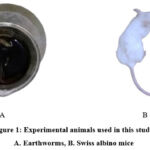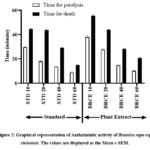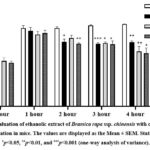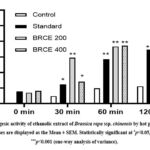Md. Nurool Amin1 , Fahad Hussain1*
, Fahad Hussain1* , Md. Monirul Islam1
, Md. Monirul Islam1 , Abul Kalam Lutful Kabir2
, Abul Kalam Lutful Kabir2 and Md. Mahmodul Islam1
and Md. Mahmodul Islam1
1Department of Pharmacy, Noakhali Science and Technology University, Noakhali, Bangladesh.
2Department of Pharmaceutical Technology, University of Dhaka, Dhaka, Bangladesh.
Corresponding Author E-mail: fahad@nstu.edu.bd
DOI : https://dx.doi.org/10.13005/bpj/2886
Abstract
Objective: Brassica rapa ssp. chinensis is a well-known vegetable plant (Family: Brassicaceae) often grown as a type of Chinese cabbage. The present study was designed to explore the thrombolytic, anthelmintic, anti-inflammatory, and antinociceptive activities of ethanolic extract of the Brassica rapa ssp. chinensis leaves. Methods: The in vitro thrombolytic activity of the leaf extract was evaluated by clot analysis using Streptokinase as a standard drug. The in vitro anthelmintic activity was assessed by applying four different concentrations of the plant extract (10 mg/ml, 20 mg/ml, 40 mg/ml, and 60mg/ml) and recording the time of paralysis and death of worms. Two different doses (100mg/kg and 250mg/kg b.w.) were administered to evaluate the anti-inflammatory activity of the carrageenan-induced paw edema model. The antinociceptive activity was evaluated by hot plate test in mice by two different doses (200mg/kg and 400 mg/kg b.w.). Results: The ethanolic leave extract had thrombolytic action, which broke up blood clots that had already formed. The ethanolic leaf extract showed both paralysis and faster worm death at those concentrations in the anthelmintic test. The extract showed significant anti-inflammatory action in pedal edema compared to the control group. The results show that the highest level of anti-inflammatory action against carrageenan-induced hind paw edema may be achieved with an ethanolic extract of Brassica rapa ssp. chinensis (250 mg/kg, p.o.). The proportion of maximum possible effect in the hot plate test was 82.49 percent in the antinociceptive evaluation. Conclusion: The pharmacological test of leaf extract endorsed the clinical uses of Brassica rapa ssp. chinensis in treating thrombosis, intestinal worms, and inflammation. Thus, this plant could be subjected to extensive bioactive compounds to discover novel therapeutic agents. Keywords: Brassica rapa ssp. chinensis, ethanolic extract, thrombolytic activity, anthelmintic activity, anti-inflammatory activity, antinociceptive activity
Keywords
Anthelmintic Activity; Anti-Inflammatory Activity; Antinociceptive Activity; Brassica rapa ssp.; Chinensis; Ethanolic Extract; Thrombolytic Activity;
Download this article as:| Copy the following to cite this article: Amin M. N, Hussain F, Islam M M, Kabir A. K. L, Islam M. M. In vivo Anti-Inflammatory and Antinociceptive Activity Evaluation of Brassica Rapa Ssp. Chinensis Ethanolic Extract with In Vitro Thrombolytic and Anthelmintic Activity Test. Biomed Pharmacol J 2024;17(1). |
| Copy the following to cite this URL: Amin M. N, Hussain F, Islam M M, Kabir A. K. L, Islam M. M. In vivo Anti-Inflammatory and Antinociceptive Activity Evaluation of Brassica Rapa Ssp. Chinensis Ethanolic Extract with In Vitro Thrombolytic and Anthelmintic Activity Test. Biomed Pharmacol J 2024;17(1). Available from: https://bit.ly/3TQ4L1u |
Introduction
Herbal remedies made from medicinal plants are excellent for treating a wide range of illnesses. Bangladesh is an ideal place to cultivate a wide variety of plants and herbs with therapeutic properties1. The family Brassicaceae includes Brassica rapa ssp. chinensis, also called pak choi, bok choy, Chinese celery cabbage, Chinese white cabbage, mustard cabbage, and choysum (Bengali: Bati shak). Often referred to as the cabbage family, the crucifer family, Brassicaceae, or Cruciferae, is a medium-sized and commercially significant family of flowering plants. The inflorescences contain flowers with four free sepals, four free alternating petals, two short and four longer free stamens, and fruit with seeds divided into rows by a thin wall (or septum)2.
Most Brassica rapa ssp. chinensis plants develop as loose heads of leaves on a pale stalk, and they are annuals to biennials. It is native to China and has spread to other Asian countries3. Considered one of the best anti-inflammatory foods, it also exhibits anti-tumor and improves digestion. It is loaded with vitamins C, K, and A, vital for healthy eyesight, protein synthesis, and the immune system. In addition, it has calcium, iron, magnesium, and potassium, all of which improve general health. Studies on epidemiology have shown that cruciferous veggies offer superior anticancer protection when compared to other fruits and vegetables4. It has a significant concentration of glucosinolates, which have antibacterial properties5,6. Myrosinase is an enzyme that aids in converting glucosinolates to their isothiocyanates. In addition, they are utilized as an antidiabetic, to treat diabetic nephropathy, to prevent Helicobacter jejuni, and to safeguard the central nervous system. Additionally, the herb demonstrated strong analgesic and antidepressant effects in a mouse model7.
The term “thrombosis” refers to the process of a blood clot forming inside a blood vessel. This clot can obstruct blood flow in the afflicted location and ultimately cause a number of disorders, including heart attacks, strokes, pulmonary emboli, and deep vein thrombosis. Along with urokinase and streptokinase, several more natural compounds have been sought after and produced8. Coumarin, found in many different plants, is the raw material used to make warfarin and other oral anticoagulants9. Helminth infections impact a significant portion of the population and are linked to various illnesses10. The need for natural medicines is growing daily because they have no adverse side effects, even if many synthetic medications are accessible to treat helminthiases. Once more, the development of anthelmintic resistance in helminths is another factor11. Unexpected illnesses and diseases can frequently result in pain-related discomfort that is either direct (physical) or indirect (mental). Specialized neurons known as nociceptors, which process pain in response to noxious stimuli, deliver pain-related information to the brain inside the central nervous system12. The production of prostaglandins, serotonin, and cyclooxygenase COX-I and II can cause acute or severe pain13. Conversely, inflammation is a common underlying cause of injury and can mediate fluid extravasation, cell migration, disruption, and restoration through a complex network of activated enzymes. Natural goods, such as those made from therapeutic plants, have the potential to be a source of novel medications14.
Hence, the present work aims to investigate the in vivo anti-inflammatory and antinociceptive effect of ethanolic extract of Brassica rapa ssp. chinensis leaves in Swiss albino mice and the in vitro thrombolytic and anthelmintic activities. The study might help explore the natural compounds responsible for treating of the above-mentioned disorders.
Materials and Methods
Plant Extract Preparation
After being obtained from Kawran Bazaar in Tejgaon, Dhaka, Bangladesh, the plant Brassica rapa ssp. chinensis was recognized by a specialist from the National Herbarium Institute in Mirpur, Dhaka, Bangladesh (DACB 64803). After that, the leaves were chopped into tiny bits, air dried at room temperature, and ground into a powder. A flat-bottom glass container containing approximately 650 g of leaf material was filled with double the volume (w/v) of ethanol (80%) at room temperature. Two weeks of ethanol soaking were followed by sporadic shaking and stirring. The mixture was then concentrated using a rotary evaporator to produce a gummy concentrate. Filtration via Whitman filter paper No. 1 was done after the mixture had first been filtered using a filter cloth.
Experimental animals
Swiss albino mice (25 ± 5 g) in both genders were acquired from the Department of Pharmacy’s Animal House at Jahangirnagar University in Dhaka, Bangladesh. The animals were housed in polycarbonate cages with a stainless-steel grid lid measuring 40 cm by 30 cm by 17 cm. The cages were naturally lit with a 12/12-hour light/dark cycle. The animal house’s temperature and humidity were kept at 23–25 °C and 50–55 percent, respectively. For the duration of the study, the animals had unrestricted access to water and specially prepared pellet meals. Before the experiments began, the mice were given a week to get used to the lab setting.
Worm sample
The earthworms were cleaned with regular saline to remove all the filth after being purchased from an aquarium store in Dhaka. Earthworms that were four to six centimeters long, one-tenth of a centimeter wide, and weighed between eight and four grams were required for all treatments. Because earthworms and the worm parasites in human intestines are similar physically and physiologically, anthelmintic activity was investigated using earthworms.
 |
Figure 1: Experimental animals used in this study, A. Earthworms, B. Swiss albino mice |
Thrombolytic activity
The thrombolytic activity of the plant extract was evaluated using the method described by Manik et al.15 . Ten healthy volunteers provided five milliliters of their venous blood, which were then placed in ten separate sterile microcentrifuge tubes that had been pre-weighed and left to incubate for forty-five minutes at 37°C. Following clot formation, all of the fluid was removed from each microcentrifuge tube, and the weight of the clot was calculated by deducting the weight of the tube containing the clot from the weight of the tube alone. The microcentrifuge tubes were filled with 100 μl of each sample, 100 μl of streptokinase as a positive control, and 100 μl of distilled water as a negative non-thrombolytic control. Following a 90-minute incubation period at 37°C, clot lysis was monitored in each tube. Following incubation, tubes were weighed once more to see if there had been any change, and the discharged fluid was disposed of. In the end, the proportion of clot lysis was ascertained as follows:

Anthelmintic activity
Nine groups, each with five worms, were used to test the anthelmintic action. The worms were released into ten milliliters of the intended formulations. The control worms in Group 1 were kept in regular distilled water. Brassica rapa ssp. chinensis leaf ethanol extract was given to groups 2–5 at 10, 20, 40, and 60 mg/ml doses. The standard group, 6–9, received treatment with albendazole (10, 20, 40, and 60 mg/ml) 16.
Anti-inflammatory activity
The anti-inflammatory activity of the aqueous extracts of Brassica rapa ssp. chinensis was evaluated by carrageenan-induced mice paw oedema method17. There were four groups of five mice each among the mice. Carrageenan (1 percent w/v) was applied to the mice’s right hind paw’s subplanter area. Normal saline was provided to the control group, indomethacin (10 mg/kg b.w.) was given to the standard group, and plant extracts were given to the experimental group at two different doses (100 mg/kg and 250 mg/kg b.w.). By injecting 0.1 ml of a 1 percent (w/v) carrageenan solution that had been prepared in regular saline, acute paw edema was produced. Vernier calipers were used to measure the paw’s circumference. Measurements were made 0–4 hours after the carrageenan was administered. The following equation was used to calculate the anti-inflammatory activity:

Anti-nociceptive activity
The anti-nociceptive effect of the extract was evaluated using hot plate method 18. Four groups of five mice each were randomly assigned to conduct a sample experiment. The experimental group received plant extracts at two doses (100 mg/kg and 200 mg/kg b.w.), the control group received normal saline, and the standard group received indomethacin (10 mg/kg b.w.). Each mouse was accurately weighed before beginning any treatment, and the doses of the test samples and the control substance (normal saline) were modified correspondingly. The extract was administered orally, and the nociceptive threshold was measured before and after at 30, 60, and 120 minutes. An index of nociceptive threshold was determined by measuring the latency to the first indication of hind paw licking or the jump response to avoid heat nociception, using a 20-s cutoff time. Results were expressed as mean percent Maximal possible effect (% MPE):

Statistical analysis
The research findings were displayed as mean ± SEM, with statistical significance indicated by p<0.05, p<0.01 and p<0.001. The test groups were compared to the control using one-way analysis of variance (ANOVA), also known as Dunnett’s test, using GraphPad Prism version 8.4 (GraphPad Software Inc., CA, USA).
Results
Thrombolytic activity
Clot lysis activity was 15.52±3.41% for the Brassica rapa ssp. chinensis extract (BRCE), whereas Streptokinase caused 83.23± 2.87% clot lysis and control caused 6.75± 4.37% clot lysis (Table 1).
Table 1: In-vitro clot lysis activity evaluation of ethanolic extract of Brassica rapa ssp. chinensis. The values are displayed as the Mean ± SEM.
|
Test sample |
Clot lysis (%) |
|
Water (negative control) |
6.75± 4.37 |
|
Streptokinase (Standard) |
83.23± 2.87 |
|
Brassica rapa ssp. chinensis extract |
15.52±3.41 |
Anthelmintic activity
When compared to the conventional albendazole (10, 20, 40, 60 mg/ml), the ethanol extract (10, 20, 40, 60 mg/ml) of leaves of Brassica rapa ssp. chinensis displayed a substantial impact on paralyzing the worms in terms of paralysis period at all concentrations (Figure 2).
 |
Figure 2: Graphical representation of Anthelmintic activity of Brassica rapa ssp. chinensis. The values are displayed as the Mean ± SEM. |
Anti-inflammatory activity
The effects of BRCE on inflammation in the paw edema induced by Carrageenan of mice were investigated. The ethanolic extract of Brassica rapa ssp. chinensis administered at a dose of 100 mg/kg showed 8.24%, 12.63%, 21.80%, 32.98%, and 250 mg/kg showed 6.31%, 19.78%, 23.14% and 35.08% inhibition at 1-4 hours. As shown in Figure 3, a significant decrease in paw edema was observed after administration of BRCE.
 |
Figure 3: In vivo evaluation of ethanolic extract of Brassica rapa ssp. chinensis with carrageenan-induced paw edema inflammation in mice. |
Anti-nociceptive Activity
Hot plate test
Mice showed a dose-dependent, statistically significant increase in tolerance to thermal stimuli in the hot plate test. When measured at 30, 60, 120, and 100 mg/kg after treatment, the animals that had received the extract 200 mg/kg beforehand exhibited a longer response in terms of latency time (Figure 4).
 |
Figure 4: Analgesic activity of ethanolic extract of Brassica rapa ssp. chinensis by hot plate method in mice. |
Discussion
Adequate dosages of herbal remedies may provide a more effective option for treating various illnesses. The study of phytochemistry and the discovery of plant chemicals useful in treating specific illnesses has reignited interest in herbal medicine.
Figure 2 shows the results of testing an extract of Brassica rapa ssp. chinensis for thrombolytic activity as part of developing medications for thrombo-occlusive disease using natural resources. Motivated by the positive control’s outcome, we compared the test sample’s eight different concentrations and the negative control, finding notable thrombolytic activity. On the other hand, these phytochemicals may oversee the clot lysis action. Because of this, more research on this leaf extract may be necessary to determine whether it has any therapeutic value in treating thrombo-occlusive disease and has any potential to be a significant player in the thrombolytic field.
The worms in the leaf extracts were paralyzed and died in the anthelmintic assay. The result was dosage dependent, and the example of ethanol extract at 60 mg/ml concentration with strong action against adult earthworms showed the shortest time necessary for paralysis and death (Pheretima posthuma). As seen in Figure 3, the extract produced outcomes similar to those of a normal medication. When compared to the reference standard albendazole, the ethanolic extract of Brassica rapa ssp. chinensis demonstrated notable anthelmintic action in a dose-dependent manner. When compared to the conventional reference medicine albendazole, the extract at a concentration of 60 mg/ml was shown to cause paralysis and death of warm in 10.04 and 20.83, respectively. This suggests that the extract may be more effective. Although the components of the compounds with anthelmintic activity were studied, an initial screening of the ethanolic extract by phytochemical methods revealed the presence of phenolic compounds19. The anthelmintic action may be due to the presence of phenolic compounds. Brassica rapa ssp. chinensis has been observed to contain phenolic compounds and steroids, which may be the cause of the action of leaves’ ethanol extract. To determine the whole profile of the ethanolic extracts’ anthelmintic potential, they can be tested against different helminth parasites.
The cyclooxygenase inhibitors that predominantly inhibit the cyclooxygenase involved in prostaglandin synthesis are used to assess the effects of non-steroidal anti-inflammatory drugs (NSAIDs) on carrageenan-induced paw edema20. It has a significant impact on the anti-inflammatory response’s second phase, which is assessed during the third hour. As demonstrated, at the 4-hour mark, there is a noteworthy percentage suppression (p<0.05) of paw edema (35% at 250 mg/kg, bw). The typical anti-inflammatory medicine indomethacin was inhibited by 55% at a dosage of 10 mg/kg, body weight. Thus, it may be concluded that the inhibition of cyclooxygenase, which in turn inhibits prostaglandin synthesis, may be the cause of the potential inhibitory impact of Brassica rapa ssp. chinensis ethanolic extract in carrageenan-induced inflammation.
At a dosage of 200 mg/kg b.w., the Brassica rapa ssp. chinensis extract exhibited strong anti-nociceptive efficacy. The potential for anti-nociception can be ascribed to inhibiting endogenous pain mediators, specifically prostaglandins, from being released. It implies that the plant may have some inhibitory effect on the prostaglandin biosynthesis-related cyclooxygenase pathway.
Conclusion
The Brassica rapa ssp. chinensis ethanol extract showed a little thrombolytic activity in the blood clot test. Blood clots detected in vitro are lysed by it; in vivo clot-dissolving qualities are still unknown. Additionally, it appeared to have anthelmintic activity. More investigation is required to determine which phytoconstituent is responsible for the anthelmintic action. We discovered the extract has potent anti-inflammatory and anti-nociceptive properties in a mouse model. Thus, more research may be done to pinpoint the exact chemical or compounds causing these actions with improved results and to gain a deeper understanding of the precise mechanism of action of the drug or compounds in question. Further research may enable us to pinpoint, separate, and describe the active primary chemical that gives this plant its functions.
Acknowledgement
We are grateful to the Department of Pharmacy, Noakhali Science and Technology University, Noakhali for providing the facilities for the accomplishment of the work.
Conflict of Interest
All authors declare no conflict of interest.
Funding Source
No. (Self-funded by the authors)
Informed Consent
No such information was applied in the paper.
Ethical approval
This study was approved by the Ethical Committee of Noakhali Science and Technology University with certificate no. NSTU/SCI/EC/2023/163(A).
References
- Islam MM, Manik N, Zobayed A, -Noor F. A review on medicinal properties some commonly used culinary agents of Bangladesh. ~ 111 ~ Journal of Medicinal Plants Studies [Internet]. 2021 [cited 2024 Jan 9];9(3):111–7. Available from: www.plantsjournal.com
- Vs RD, Shankar S, Sathiavelu M, Segaran G. Brassicaceae-A Classical Review on Its Pharmacological Activities. Article in International Journal of Pharmaceutical Sciences Review and Research [Internet]. 2019 [cited 2024 Jan 6];55(1):107–13. Available from: www.globalresearchonline.net
- CUI X min, DONG Y xiu, HOU X lin, CHENG Y, ZHANG J yi, JIN M feng. Development and Characterization of Microsatellite Markers in Brassica rapa ssp. chinensis and Transferability Among Related Species. Agric Sci China. 2008 Jan 1;7(1):19–31.
CrossRef - Domínguez-Perles R, Mena P, García-Viguera C, Moreno DA. Brassica foods as a dietary source of vitamin C: a review. Crit Rev Food Sci Nutr [Internet]. 2014 [cited 2024 Jan 6];54(8):1076–91. Available from: https://pubmed.ncbi.nlm.nih.gov/24499123/
CrossRef - Wiesner M, Zrenner R, Krumbein A, Glatt H, Schreiner M. Genotypic variation of the glucosinolate profile in pak choi (Brassica rapa ssp. chinensis). J Agric Food Chem [Internet]. 2013 Feb 27 [cited 2024 Jan 6];61(8):1943–53. Available from: https://pubs.acs.org/doi/abs/10.1021/jf303970k
CrossRef - Saladino F, Bordin K, Luciano FB, Franzón MF, Mañes J, Meca G. Antimicrobial Activity of the Glucosinolates. Reference Series in Phytochemistry [Internet]. 2017 [cited 2024 Jan 6];249–74. Available from: https://link.springer.com/referenceworkentry/10.1007/978-3-319-25462-3_18
CrossRef - Rahman MS, Jahan N, Rahman SMA, Rashid MA. Analgesic and antidepressant activities of Brassica rapa subspecies chinensis (L.) Hanelt on Swiss-albino mice model. Bangladesh Med Res Counc Bull [Internet]. 2015 [cited 2024 Jan 6];41(3):114–20. Available from: https://pubmed.ncbi.nlm.nih.gov/29870165/
CrossRef - Hussain F, Islam M, Bulbul L, Rahman Moghal M, Hossain M. In vitro thrombolytic potential of root extracts of four medicinal plants available in Bangladesh. Anc Sci Life [Internet]. 2014 [cited 2024 Feb 13];33(3):160. Available from: https://pubmed.ncbi.nlm.nih.gov/25538351/
CrossRef - Lee HS. How Safe is the Readministration of Streptokinase? Drug Saf [Internet]. 1995 Oct 26 [cited 2024 Jan 6];13(2):76–80. Available from: https://link.springer.com/article/10.2165/00002018-199513020-00002
CrossRef - Hotez PJ, Brindley PJ, Bethony JM, King CH, Pearce EJ, Jacobson J. Helminth infections: the great neglected tropical diseases. J Clin Invest [Internet]. 2008 Apr 4 [cited 2024 Jan 6];118(4):1311. Available from: /pmc/articles/PMC2276811/
CrossRef - Iqbal Z, Lateef M, Ashraf M, Jabbar A. Anthelmintic activity of Artemisia brevifolia in sheep. J Ethnopharmacol. 2004 Aug 1;93(2–3):265–8.
CrossRef - Vardeh D, Mannion RJ, Woolf CJ. Toward a Mechanism-Based Approach to Pain Diagnosis. J Pain [Internet]. 2016 Sep 1 [cited 2024 Jan 6];17(9 Suppl):T50–69. Available from: https://pubmed.ncbi.nlm. nih.gov/27586831/
CrossRef - Nahar K, Fatema-Tuz-Zohora, Begum R, Hasan M, Aziz A, Jui Y, et al. Isolation and Evaluation of Cytotoxic, Anti-Inflammatory, Anti-Ulcer Activity of Methanolic Extract of Ceriops decandra leaves. Biomedical and Pharmacology Journal. 2023 Sep 1;16(3):1681–91.
CrossRef - Al Mahmud Z, Emran T Bin, Qais N, Bachar SC, Sarker M, Nasir Uddin MM. Evaluation of analgesic, anti-inflammatory, thrombolytic and hepatoprotective activities of roots of Premna esculenta (Roxb). J Basic Clin Physiol Pharmacol [Internet]. 2016 Jan 1 [cited 2024 Jan 6];27(1):63–70. Available from: https://pubmed.ncbi.nlm.nih. gov/26457773/
CrossRef - Manik MIN, Ali MH, Islam MM, Zobayed A, Saadullah, Khan A, et al. In vitro Antioxidant, Cytotoxic, Thrombolytic Activities and Phytochemical Evaluation of Methanol Extract of the Ampelocissus Barbata (Wall.) Leaves. Biomedical and Pharmacology Journal. 2022;15(2):911–23.
CrossRef - Hussain A, Sonkar AK, Ahmad MP, Wahab S. In-vitro anthelmintic activity of Coleus aromaticus root in Indian Adult Earthworm. Asian Pac J Trop Dis. 2012 Jan 1;2(SUPPL.1):S425–7.
CrossRef - Gupta AK, Parasar D, Sagar A, Choudhary V, Chopra BS, Garg R, et al. Analgesic and Anti-Inflammatory Properties of Gelsolin in Acetic Acid Induced Writhing, Tail Immersion and Carrageenan Induced Paw Edema in Mice. PLoS One [Internet]. 2015 Aug 14 [cited 2024 Jan 7];10(8):e0135558. Available from: https://journals.plos.org/ plosone/article?id=10.1371/journal.pone.0135558
CrossRef - Tita B, Abdel-Haq H, Vitalone A, Mazzanti G, Saso L. Analgesic properties of Epilobium angustifolium, evaluated by the hot plate test and the writhing test. Il Farmaco. 2001 Jul 1;56(5–7):341–3.
CrossRef - Yeo HJ, Ki WY, Lee S, Kim CY, Kim JK, Park SU, et al. Metabolite profiles and biological activities of different phenotypes of Chinese cabbage (Brassica rapa ssp. Pekinensis). Food Research International. 2023 Dec 1;174:113619.
CrossRef - Amdekar S, Roy P, Singh V, Kumar A, Singh R, Sharma P. Anti-inflammatory activity of lactobacillus on carrageenan-induced paw edema in male wistar rats. Int J Inflam [Internet]. 2012 [cited 2024 Jan 7];2012. Available from: https://pubmed.ncbi.nlm.nih.gov/22518342/
CrossRef







